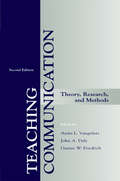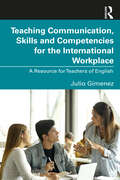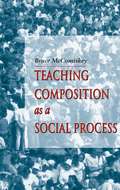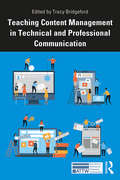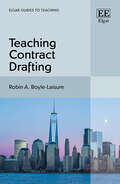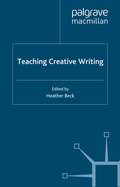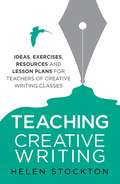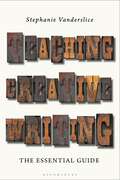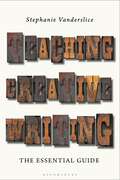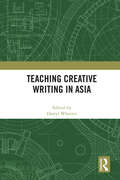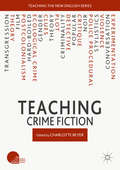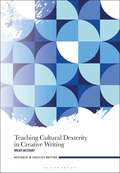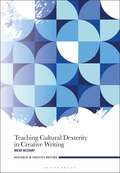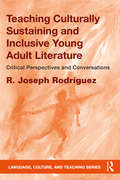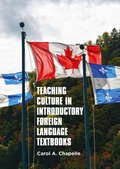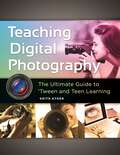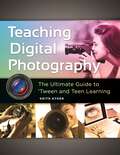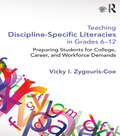- Table View
- List View
Teaching Communication: Theory, Research, and Methods
by Anita L. Vangelisti John A. Daly Gustav W. FriedrichThe field of communication was founded, in part, because of a need to make people better communicators. That meant teaching them how to communicate more effectively, whether it be in public settings or in private. Most of that teaching has happened within the classroom and many professionals have spent their lives instructing others on various aspects of communication. Inside this second edition, the editors have assembled a fully comprehensive and contemporary discussion of topics and issues concerning the teaching of communication. The chapters contained herein--contributed by key voices throughout the communication discipline--address conceptual as well as practical issues related to communication instruction. The contents of this new edition reflect the dramatic changes that have occurred in communication education since the publication of the first edition in 1990. This book focuses initially on the goals of communication education, then delves into the preparation of specific communication courses. It includes assistance for instructors in organizing instructional content and discusses the use of instructional strategies and tools, as well as offering ideas on evaluating the processes and products of instruction. The volume also covers unique teaching assignments that may be encountered, from the basic course to continuing education, and addresses 2-year college teaching, directing forensic programs, distance education, and consulting. It concludes with important professional issues faced by both new and experienced communication instructors, including ethics and political issues within classrooms and departments. This volume is a necessity for anyone starting out a career as a communication instructor. Veteran educators--who know that learning to teach is a continual growth experience--will find useful and invaluable information within the book's pages. Whatever background and level of experience, all communication educators will find this new edition to be an essential resource for their work.
Teaching Communication: Theory, Research, and Methods
by Anita L. Vangelisti John A. Daly Gustav W. FriedrichThe field of communication was founded, in part, because of a need to make people better communicators. That meant teaching them how to communicate more effectively, whether it be in public settings or in private. Most of that teaching has happened within the classroom and many professionals have spent their lives instructing others on various aspects of communication. Inside this second edition, the editors have assembled a fully comprehensive and contemporary discussion of topics and issues concerning the teaching of communication. The chapters contained herein--contributed by key voices throughout the communication discipline--address conceptual as well as practical issues related to communication instruction. The contents of this new edition reflect the dramatic changes that have occurred in communication education since the publication of the first edition in 1990. This book focuses initially on the goals of communication education, then delves into the preparation of specific communication courses. It includes assistance for instructors in organizing instructional content and discusses the use of instructional strategies and tools, as well as offering ideas on evaluating the processes and products of instruction. The volume also covers unique teaching assignments that may be encountered, from the basic course to continuing education, and addresses 2-year college teaching, directing forensic programs, distance education, and consulting. It concludes with important professional issues faced by both new and experienced communication instructors, including ethics and political issues within classrooms and departments. This volume is a necessity for anyone starting out a career as a communication instructor. Veteran educators--who know that learning to teach is a continual growth experience--will find useful and invaluable information within the book's pages. Whatever background and level of experience, all communication educators will find this new edition to be an essential resource for their work.
Teaching Communication, Skills and Competencies for the International Workplace: A Resource for Teachers of English
by Julio GimenezBacked by evidence and research, this practical book presents an innovative yet comprehensive approach to teaching non-native English speakers the main communication and cultural competencies that are required to succeed in an international English-speaking workplace. Each unit includes strategies for teaching key skills, tasks to encourage reflection and notes on relevant cultural and technological issues. Practical features in each unit include lesson plans and materials, insights from research, extension tasks, reflection activities and further readings. Supported by current learning theories, key teaching methodologies and assessment materials, the chapters address the challenges that non-native English speakers may face in the international English-speaking workplace. Areas of focus include: Job hunting Job applications Interviews Interpersonal, written and spoken communication Performance appraisals Applying for promotions Written for pre-service, practicing and future teachers, with specific guidance for each role, this is an essential resource for all educators who want to confidently address the challenges that non-English speakers may encounter at work, including linguistic proficiency, cultural awareness and the use of technology.
Teaching Communication, Skills and Competencies for the International Workplace: A Resource for Teachers of English
by Julio GimenezBacked by evidence and research, this practical book presents an innovative yet comprehensive approach to teaching non-native English speakers the main communication and cultural competencies that are required to succeed in an international English-speaking workplace. Each unit includes strategies for teaching key skills, tasks to encourage reflection and notes on relevant cultural and technological issues. Practical features in each unit include lesson plans and materials, insights from research, extension tasks, reflection activities and further readings. Supported by current learning theories, key teaching methodologies and assessment materials, the chapters address the challenges that non-native English speakers may face in the international English-speaking workplace. Areas of focus include: Job hunting Job applications Interviews Interpersonal, written and spoken communication Performance appraisals Applying for promotions Written for pre-service, practicing and future teachers, with specific guidance for each role, this is an essential resource for all educators who want to confidently address the challenges that non-English speakers may encounter at work, including linguistic proficiency, cultural awareness and the use of technology.
Teaching Composition As A Social Process
by Bruce MccomiskeyBruce McComiskey is a strong advocate of social approaches to teaching writing. However, he opposes composition teaching that relies on cultural theory for content, because it too often prejudges the ethical character of institutions and reverts unnecessarily to product-centered practices in the classroom. He opposes what he calls the "read-this-essay-and-do-what-the-author-did method of writing instruction: read Roland Barthes's essay 'Toys' and write a similar essay; read John Fiske's essay on TV and critique a show." McComiskey argues for teaching writing as situated in discourse itself, in the constant flow of texts produced within social relationships and institutions. He urges writing teachers not to neglect the linguistic and rhetorical levels of composing, but rather to strengthen them with attention to the social contexts and ideological investments that pervade both the processes and products of writing. A work with a sophisticated theory base, and full of examples from McComiskey's own classrooms, Teaching Composition as a Social Process will be valued by experienced and beginning composition teachers alike.
Teaching Content Management in Technical and Professional Communication (ATTW Series in Technical and Professional Communication)
by Tracy BridgefordThis collection offers a comprehensive overview of approaches to teaching the complex subject of content management. The 12 chapters define and explain content management and its accompanying competencies, providing teaching examples in areas including content strategy, topic-based writing, usability studies, and social media. The book covers tasks associated with content management such as analyzing audiences and using information architecture languages including XML and DITA. It highlights the communal aspects of content management, focusing on the work of writing stewardship and project management, and the characteristics of content management in global contexts. It concludes with a look to the future and the forces that shape content management today. The editor situates the collection within a pedagogical exigency, providing sound instructional approaches to teaching content management from a rhetorical perspective. The book is an essential resource for both instructors new to teaching technical and professional communication, and experienced instructors who are interested in upgrading their pedagogies to include content management.
Teaching Content Management in Technical and Professional Communication (ATTW Series in Technical and Professional Communication)
by Tracy BridgefordThis collection offers a comprehensive overview of approaches to teaching the complex subject of content management. The 12 chapters define and explain content management and its accompanying competencies, providing teaching examples in areas including content strategy, topic-based writing, usability studies, and social media. The book covers tasks associated with content management such as analyzing audiences and using information architecture languages including XML and DITA. It highlights the communal aspects of content management, focusing on the work of writing stewardship and project management, and the characteristics of content management in global contexts. It concludes with a look to the future and the forces that shape content management today. The editor situates the collection within a pedagogical exigency, providing sound instructional approaches to teaching content management from a rhetorical perspective. The book is an essential resource for both instructors new to teaching technical and professional communication, and experienced instructors who are interested in upgrading their pedagogies to include content management.
Teaching Contract Drafting (Elgar Guides to Teaching)
by Robin A. Boyle-LaisureThis comprehensive guide covers every stage of organising and teaching a course in contract drafting. With extensive sample course materials, it offers useful tips for building nuance, creative thinking, and experiential learning into contract drafting curricula. Chapters give detailed definitions and examples of core contract concepts including representations and warranties; covenants; conditions; discretionary authority; and declarations. Exploring complex issues such as ethical negotiation, cross-border transactions and the impact of technology on contracts, it presents a nuanced syllabus that can be adapted for courses that focus exclusively on contract drafting as well as those that contain other elements. The book provides tested examples of exercise sets, grading rubrics, sample contracts and peer-to-peer activities, focusing on engaging students in the dynamics of a client interaction. It turns to neuroscience and learning theory to identify effective pedagogical approaches, giving concrete recommendations for how these can be implemented in the classroom.Professors and instructors teaching contract law, as well as any form of transactional practice will find this book invaluable in developing their courses, with expert guidance on how to boost student understanding and engagement.
Teaching Creative Writing (Teaching the New English)
by Heather BeckTeaching Creative Writing includes lively contributions from two dozen leading practitioners in the field. Topics addressed include history of Creative Writing, workshops, undergraduate, postgraduate, reflective activities, assessment, critical theory, and information technology.
Teaching Creative Writing: Ideas, exercises, resources and lesson plans for teachers of creative-writing classes
by Helen StocktonIf you teach creative writing or facilitate a writing group, you will want to inspire, inform and encourage would-be writers. This book is a unique, practical resource offering guidance, ideas and exercises to help you do just that. It moves from planning and structuring courses to giving ideas and exercises on all the key aspects of creative writing, providing a wealth of really useful advice and tips. It will enable you to pass on your particular expertise and enthusiasm imaginatively and professionally to all your students.· Guidance on teaching all the skills of creative writing· Ideas on lesson content, example exercises and setting homework· Support on dealing with problems and adapting for different abilities· Tips on group management and feedback· A – Z of specific genres with examples of learning activities.This book will ensure that your teaching will be effective, fun and immensely rewarding.
Teaching Creative Writing: The Essential Guide
by Professor Stephanie VandersliceThe only textbook of its kind, this all-in-one introduction guides you through the history, theories and practices of creative writing you need to know to teach this ever-expanding and infinitely rewarding subject successfully in higher education. Asking you to think reflectively about the discipline throughout, this book offers a bridge between teaching and learning of the subject to help you develop effective and informed methods that will enliven your classroom and help you discover the best practice for you. Based on the author's two decades of teaching and research in creative writing theory and pedagogy, and on feedback from a range of instructors in the field, Stephanie Vanderslice brings forward this essential companion for students and teachers engaging with the study and instruction of creative writing. Written in Vanderslice's trademark cogent, conversational style, Teaching Creative Writing gives you the tools to understand creative writing as a subject and a practice and offers you a ready-to-use blueprint for planning your first creative writing classes. It covers such critical topics as: - How research into the development of the creative writer might influence your classroom environment - The need to free students from damaging myths and pervasive lore - The use of revision and editing - Creating inclusive classroom spaces and workshops - The place of genre in creative writing - Teaching students to work multi-modally - How to assess and grade work - Introducing students to the literary community - Teaching creative writing online Building on what it means to teach creative writing in the 21st century, this book leads you through creating your own syllabi, course plans, and statements of teaching philosophies, features capsule interviews with experts on key topics, and includes an online companion resource which features teacher guides to using the book.
Teaching Creative Writing: The Essential Guide
by Professor Stephanie VandersliceThe only textbook of its kind, this all-in-one introduction guides you through the history, theories and practices of creative writing you need to know to teach this ever-expanding and infinitely rewarding subject successfully in higher education. Asking you to think reflectively about the discipline throughout, this book offers a bridge between teaching and learning of the subject to help you develop effective and informed methods that will enliven your classroom and help you discover the best practice for you. Based on the author's two decades of teaching and research in creative writing theory and pedagogy, and on feedback from a range of instructors in the field, Stephanie Vanderslice brings forward this essential companion for students and teachers engaging with the study and instruction of creative writing. Written in Vanderslice's trademark cogent, conversational style, Teaching Creative Writing gives you the tools to understand creative writing as a subject and a practice and offers you a ready-to-use blueprint for planning your first creative writing classes. It covers such critical topics as: - How research into the development of the creative writer might influence your classroom environment - The need to free students from damaging myths and pervasive lore - The use of revision and editing - Creating inclusive classroom spaces and workshops - The place of genre in creative writing - Teaching students to work multi-modally - How to assess and grade work - Introducing students to the literary community - Teaching creative writing online Building on what it means to teach creative writing in the 21st century, this book leads you through creating your own syllabi, course plans, and statements of teaching philosophies, features capsule interviews with experts on key topics, and includes an online companion resource which features teacher guides to using the book.
Teaching Creative Writing in Asia
by Darryl WhetterThis book examines the dynamic landscape of creative educations in Asia, exploring the intersection of post-coloniality, translation, and creative educations in one of the world’s most relevant testing grounds for STEM versus STEAM educational debates. Several essays attend to one of today’s most pressing issues in Creative Writing education, and education generally: the convergence of the former educational revolution of Creative Writing in the anglophone world with a defining aspect of the 21st-century—the shift from monolingual to multilingual writers and learners. The essays look at examples from across Asia with specific experience from India, Singapore, China, Hong Kong, the Philippines and Taiwan. Each of the 14 writer-professor contributors has taught Creative Writing substantially in Asia, often creating and directing the first university Creative Writing programs there. This book will be of interest to anyone following global trends within creative writing and those with an interest in education and multilingualism in Asia.
Teaching Creative Writing in Asia
by Darryl WhetterThis book examines the dynamic landscape of creative educations in Asia, exploring the intersection of post-coloniality, translation, and creative educations in one of the world’s most relevant testing grounds for STEM versus STEAM educational debates. Several essays attend to one of today’s most pressing issues in Creative Writing education, and education generally: the convergence of the former educational revolution of Creative Writing in the anglophone world with a defining aspect of the 21st-century—the shift from monolingual to multilingual writers and learners. The essays look at examples from across Asia with specific experience from India, Singapore, China, Hong Kong, the Philippines and Taiwan. Each of the 14 writer-professor contributors has taught Creative Writing substantially in Asia, often creating and directing the first university Creative Writing programs there. This book will be of interest to anyone following global trends within creative writing and those with an interest in education and multilingualism in Asia.
Teaching Crime Fiction (Teaching the New English)
by Charlotte BeyerMore than perhaps any other genre, crime fiction invites debate over the role of popular fiction in English studies. This book offers lively original essays on teaching crime fiction written by experienced British and international scholar teachers, providing vital insight into this diverse genre through a series of compelling subjects. Taking its starting-point in pedagogical reflections and classroom experiences, the book explores methods for teaching students to develop their own critical perspectives as crime fiction critics, the impact of feminism, postcolonialism, and ecocriticism on crime fiction, crime fiction and film, the crime short story, postgraduate perspectives, and more.
Teaching Crime Fiction (Teaching the New English)
by Charlotte BeyerMore than perhaps any other genre, crime fiction invites debate over the role of popular fiction in English studies. This book offers lively original essays on teaching crime fiction written by experienced British and international scholar teachers, providing vital insight into this diverse genre through a series of compelling subjects. Taking its starting-point in pedagogical reflections and classroom experiences, the book explores methods for teaching students to develop their own critical perspectives as crime fiction critics, the impact of feminism, postcolonialism, and ecocriticism on crime fiction, crime fiction and film, the crime short story, postgraduate perspectives, and more.
Teaching Cultural Dexterity in Creative Writing (Research in Creative Writing)
by Micah McCraryAimed toward graduate student instructors and other creative writing educators, Teaching Cultural Dexterity in Creative Writing offers a formula for important changes in creative writing instruction-especially in literary/creative nonfiction, probing how instruction might become more inclusive and accessible for minoritized/marginalized student-authors. The book chapters use antiracist, trauma-informed, and anticolonial frameworks toward exploring the 21st-century professional, theoretical, and institutional concerns surrounding creative writing practices in North American higher education. As a result, the book explores ways creative writing pedagogies and theories might be adapted for racially and linguistically marginalized (by English) student-authors, who often inhabit minoritized positions within North American colleges and universities.This book provides resources toward culturally dexterous nonfiction curricula, through the discussion of course readings, writing prompts following every chapter, and additional sample course materials. As cultural dexterity has been explored to allow medical students to engage effectively with patients from multiple backgrounds, ethnic groups, and sensitivities, Teaching Cultural Dexterity in Creative Writing examines why and how creative writing instruction must also be renegotiated.Applying as a frame the notion of cultural dexterity as it is taught to medical professionals to allow them to engage effectively with patients from all backgrounds, ethnics groups and with all sensitivities, Teaching Cultural Dexterity in Creative Writing examines why and how creative writing instruction needs to be urgently renegotiated. In this essential text for all creative writing instructors, McCray provides all the tools necessary to take positive action with discussions of potential readings, writing prompts and sample course materials.
Teaching Cultural Dexterity in Creative Writing (Research in Creative Writing)
by Micah McCraryAimed toward graduate student instructors and other creative writing educators, Teaching Cultural Dexterity in Creative Writing offers a formula for important changes in creative writing instruction-especially in literary/creative nonfiction, probing how instruction might become more inclusive and accessible for minoritized/marginalized student-authors. The book chapters use antiracist, trauma-informed, and anticolonial frameworks toward exploring the 21st-century professional, theoretical, and institutional concerns surrounding creative writing practices in North American higher education. As a result, the book explores ways creative writing pedagogies and theories might be adapted for racially and linguistically marginalized (by English) student-authors, who often inhabit minoritized positions within North American colleges and universities.This book provides resources toward culturally dexterous nonfiction curricula, through the discussion of course readings, writing prompts following every chapter, and additional sample course materials. As cultural dexterity has been explored to allow medical students to engage effectively with patients from multiple backgrounds, ethnic groups, and sensitivities, Teaching Cultural Dexterity in Creative Writing examines why and how creative writing instruction must also be renegotiated.Applying as a frame the notion of cultural dexterity as it is taught to medical professionals to allow them to engage effectively with patients from all backgrounds, ethnics groups and with all sensitivities, Teaching Cultural Dexterity in Creative Writing examines why and how creative writing instruction needs to be urgently renegotiated. In this essential text for all creative writing instructors, McCray provides all the tools necessary to take positive action with discussions of potential readings, writing prompts and sample course materials.
Teaching Culturally Sustaining and Inclusive Young Adult Literature: Critical Perspectives and Conversations (Language, Culture, and Teaching Series)
by R. Joseph RodríguezIn this book, Rodríguez uses theories of critical literacy and culturally responsive teaching to argue that our schools, and our culture, need sustaining and inclusive young adult (YA) literature/s to meet the needs of culturally and linguistically diverse readers and all students. This book provides an outline for the study of literature through cultural and literary criticism, via essays that analyze selected YA literature (drama, fiction, nonfiction, and poetry) in four areas: scribal identities and the self-affirmation of adolescents; gender and sexualities; schooling and education of young adult characters; and teachers’ roles and influences in characters’ coming of age. Applying critical literacy theories and a youth studies lens, this book shines a light on the need for culturally sustaining and inclusive pedagogies to read adolescent worlds. Complementing these essays are critical conversations with seven key contemporary YA literature writers, adding biographical perspectives to further expand the critical scholarship and merits of YA literature.
Teaching Culturally Sustaining and Inclusive Young Adult Literature: Critical Perspectives and Conversations (Language, Culture, and Teaching Series)
by R. Joseph RodríguezIn this book, Rodríguez uses theories of critical literacy and culturally responsive teaching to argue that our schools, and our culture, need sustaining and inclusive young adult (YA) literature/s to meet the needs of culturally and linguistically diverse readers and all students. This book provides an outline for the study of literature through cultural and literary criticism, via essays that analyze selected YA literature (drama, fiction, nonfiction, and poetry) in four areas: scribal identities and the self-affirmation of adolescents; gender and sexualities; schooling and education of young adult characters; and teachers’ roles and influences in characters’ coming of age. Applying critical literacy theories and a youth studies lens, this book shines a light on the need for culturally sustaining and inclusive pedagogies to read adolescent worlds. Complementing these essays are critical conversations with seven key contemporary YA literature writers, adding biographical perspectives to further expand the critical scholarship and merits of YA literature.
Teaching Culture in Introductory Foreign Language Textbooks
by Carol A. ChapelleThis book demonstrates how foreign language textbook analysis can inform future materials development to improve foreign language teaching. Through chronological analysis of French textbooks in the United States, this book explores the representations of Canada and Quebec in French beginner textbooks produced from 1960 to 2010. Chapelle couples a large collection of 65 textbooks with a social-semiotic qualitative analysis of the genres, language and images that communicate Quebec's cultural narrative to learners. Findings about the amount and type of content are presented by decade to track the trends in foreign language teaching and changes in Quebec’s representation. Particular attention is given to how language politics is presented to students through text and images. This book will be of interest to scholars of Canadian Studies, Quebec Studies and Second Language Acquisition, as well as foreign language materials developers.
Teaching Digital Photography: The Ultimate Guide to 'Tween and Teen Learning
by Keith KykerThis book provides a full-year curriculum for educators wishing to teach a digital photography/multimedia class that will endow students with the technical skills for producing complex digital imaging projects.Digital imaging devices are everywhere, and most households have several—digital cameras, smartphones with cameras, and GoPro action cameras. With the right techniques and software, today's high-tech equipment can be used to create outstanding photographs or stunning digital imaging projects. This book allows any educator to teach digital photography/video and multimedia, regardless of previous experience with digital imaging, supplying tested and proven lesson plans, hands-on project ideas, and grading rubrics for a full-year course.Ideal for middle school, high school, and community college teachers as well as public youth services librarians, particularly those embracing the makerspace movement, Teaching Digital Photography: The Ultimate Guide to 'Tween and Teen Learning provides a detailed educational plan advising how to purchase equipment, set up a classroom or library area to be used for instruction, and instruct the students in the skills needed to become excellent digital photographers. The first half of the book focuses on establishing the class: the general philosophy, the classroom, and the equipment. Three chapters are dedicated to exploring the best ways to teach students the skills of photography, digital image improvement, and digital layout. The final sections of the book provide more than 20 digital layout projects and cover digital video production.
Teaching Digital Photography: The Ultimate Guide to 'Tween and Teen Learning
by Keith KykerThis book provides a full-year curriculum for educators wishing to teach a digital photography/multimedia class that will endow students with the technical skills for producing complex digital imaging projects.Digital imaging devices are everywhere, and most households have several—digital cameras, smartphones with cameras, and GoPro action cameras. With the right techniques and software, today's high-tech equipment can be used to create outstanding photographs or stunning digital imaging projects. This book allows any educator to teach digital photography/video and multimedia, regardless of previous experience with digital imaging, supplying tested and proven lesson plans, hands-on project ideas, and grading rubrics for a full-year course.Ideal for middle school, high school, and community college teachers as well as public youth services librarians, particularly those embracing the makerspace movement, Teaching Digital Photography: The Ultimate Guide to 'Tween and Teen Learning provides a detailed educational plan advising how to purchase equipment, set up a classroom or library area to be used for instruction, and instruct the students in the skills needed to become excellent digital photographers. The first half of the book focuses on establishing the class: the general philosophy, the classroom, and the equipment. Three chapters are dedicated to exploring the best ways to teach students the skills of photography, digital image improvement, and digital layout. The final sections of the book provide more than 20 digital layout projects and cover digital video production.
Teaching Discipline-Specific Literacies in Grades 6-12: Preparing Students for College, Career, and Workforce Demands
by Vicky I. Zygouris-CoeComprehensive, timely, and relevant, this text offers an approach to discipline-specific literacy instruction that is aligned with the Common Core State Standards and the needs of teachers, students, and secondary schools across the nation. It is essential that teachers know how to provide instruction that both develops content and literacy knowledge and skills, and aims at reducing student achievement gaps. Building on the research-supported premise that discipline-specific reading instruction is key to achieving these goals, this text provides practical guidance and strategies for prospective and practicing content area teachers (and other educators) on how to prepare all students to succeed in college and the workforce. Pedagogical features in each chapter engage readers in digging deeper and in applying the ideas and strategies presented in their own contexts: Classroom Life (real 6-12 classroom scenarios and interviews with content-area teachers) Common Core State Standards Connections College, Career, and Workforce Connections Applying Discipline-Specific Literacies Think Like an Expert ("habits of thinking and learning" specific to each discipline) Digital Literacies Differentiating Instruction Reflect and Apply Questions Extending Learning Activities The Companion Website includes: Lesson plan resources Annotated links to video files Annotated links to additional resources and information Glossary/Flashcards For Instructors: All images and figures used in the text provided in an easily downloadable format For Instructors: PowerPoint lecture slides
Teaching Discipline-Specific Literacies in Grades 6-12: Preparing Students for College, Career, and Workforce Demands
by Vicky I. Zygouris-CoeComprehensive, timely, and relevant, this text offers an approach to discipline-specific literacy instruction that is aligned with the Common Core State Standards and the needs of teachers, students, and secondary schools across the nation. It is essential that teachers know how to provide instruction that both develops content and literacy knowledge and skills, and aims at reducing student achievement gaps. Building on the research-supported premise that discipline-specific reading instruction is key to achieving these goals, this text provides practical guidance and strategies for prospective and practicing content area teachers (and other educators) on how to prepare all students to succeed in college and the workforce. Pedagogical features in each chapter engage readers in digging deeper and in applying the ideas and strategies presented in their own contexts: Classroom Life (real 6-12 classroom scenarios and interviews with content-area teachers) Common Core State Standards Connections College, Career, and Workforce Connections Applying Discipline-Specific Literacies Think Like an Expert ("habits of thinking and learning" specific to each discipline) Digital Literacies Differentiating Instruction Reflect and Apply Questions Extending Learning Activities The Companion Website includes: Lesson plan resources Annotated links to video files Annotated links to additional resources and information Glossary/Flashcards For Instructors: All images and figures used in the text provided in an easily downloadable format For Instructors: PowerPoint lecture slides
